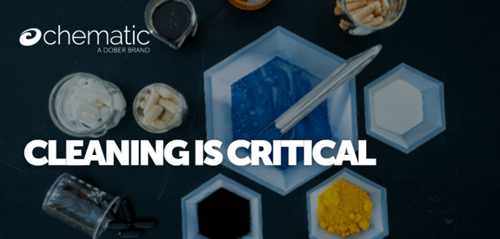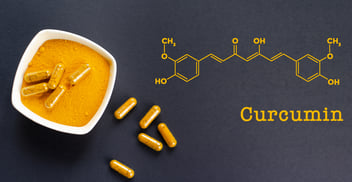Lesson 2: Benefits of Improving Your Cleaning Program
In this course, "Intro to Formulated Detergents," we'll walk you through the benefits of improving your industrial cleaning program.
In case you missed it, you can check out Lesson 1, in which we talk about why industrial cleaning is critical.
Whether you're looking to improve your facility's cleaning processes, have a pretty good process already but just want to learn more or you need to devote more intentional thinking to cleaning, we hope these reading materials will help you on your way.

benefits of improving your program
Let's revisit the comparison of cleaning in the industrial/manufacturing setting versus cleaning in a place like the home.
In the home, you might not consider the efficiency of your cleaning products as closely as a business might. But if you notice a certain cleaning product requires you to use more to clean a surface area than you might think you'd need, you'd probably think about switching products. You then find one that works more quickly and, as a result, requires you to use less chemical product. 
The result?
You've saved time spent on cleaning, which you can then use to do other things. Time is money, after all. In addition, you possibly even saved money on cleaning supplies. Rather than two or three bottles of Ineffective Cleaner A, you might only need one bottle of Effective Cleaner B.
With all of that said, in an industrial/manufacturing environment, the stakes are much higher and present at a much larger scale. When you're considering the amount of cleaning that, say, a pharmaceutical manufacturing operation needs to do an annual basis, it's much more significant than a household saving a few bucks here or there.
However, the core benefits of improving your industrial cleaning program generally remain the same, with a few additions.
By actively striving to improve your program, you can:
CREATE A SAFE PROCESS FOR PERSONNEL, EQUIPMENT & ENVIRONMENT
- Minimize manual labor (e.g., scrubbing)
- Reduce materials, including cleaning agents and water use
- Avoid unnecessary stress to equipment
REDUCE CLEANING TIME
- Analyze current cleaning process and parameters
- Compile a defined and fixed cleaning cycle
- Simplify the process (no unnecessary steps)
RELIABILITY IN CLEANING
- Design process for achieving consistent results
- Create customized process (simplified and efficient)
Benefits by the Numbers: A Case study
We've outlined the benefits of improving your industrial cleaning program, but what about some numbers from the field? How much time, exactly, can be saved?
In one case study, we analyzed one company — a global manufacturer of curcumin products — slashed its cleaning time by a significant amount. As you may know, curcumin can be a pesky ingredient to clean if you don't have the right tools or process in place.
Dober Critical Cleaning Lab Manager Jessica Kask explains:
Turmeric (curcumin) is a yellow powder that can easily stain surfaces, especially when wet or blended with oil. The lightweight powder also spreads easily so it can affect all areas of the equipment train. Even the walls and floors of production rooms can be affected. If an ingredient has very specific working characteristics so should your cleaning solution.
The cleaning detergent industry offers many one-size-fits-all solutions but so few are designed to your specific needs. Generic cleaners typically lack the ability to trap and suspend the pigmented material which can lead to settling out of solution and redepositing on the surfaces you are trying to clean. One of the greatest impacts on production is re-cleaning because a cleaning agent is underperforming. Not only do throughput and production capacity in the manufacturing process suffer, but so too can the quality of the finished product.
After switching to a more effective cleaning product, the company in the case study reduced its average cleaning time from over 16 hours to 2-3 hours. What did that mean for the company?
- More production time
- Able to keep up with increasing demand
- Able to bring new products to market
While the numbers might be different from company to company, any operation can reap the benefits of an improved cleaning program: saving time on cleaning in favor of more production, creating a safer cleaning process for personnel, and implementing a more consistent and reliable cleaning program. Particularly in highly regulated spaces, like the pharmaceutical industry, consistency is king.
the all-important question: What About Cost?
Now, you might be thinking, "that all sounds good, but it's just too costly to consider switching products or changing how I clean."
However, it's a misconception that taking steps to improve your cleaning program has to entail higher costs.
In the video below, Kask and Dober Chematic Director Kristina Wesley give you a quick summary of why you should think big picture when it comes to cleaning costs:
Five key traits of a Quality industrial Cleaning Program
To bring it all together and reiterate something we noted in Lesson 1, but there are five key traits of a quality industrial cleaning program. Think about your operation: how many of these would you say yours has?
A quality cleaning program features:
- A repeatable cleaning process
- A reputable cleaning agent (designed for your specific manufacturing process)
- Safety — handling by your people, the environment, etc.
- Efficiency — more internal message, cost avoidance, labor savings
- Consistency — meets consumer expectations
summary
Taking steps to improve your cleaning program isn't just a luxury you consider only when you think you "have time" or, worse, when something does go wrong. If you haven't audited your cleaning process and tracked key metrics to determine efficiency (e.g., how much time you're spending on recleaning equipment), one key takeaway we want to you leave this lessons with is this:
It's never too late to start thinking about how to improve your cleaning program.
Saving time, increasing production and having a safer environment for your personnel are some of the bigger benefits you might achieve by actively working to improve your industrial cleaning program.
This concludes the the second installment of this course, "Intro to Formulated Detergents." Continue on to Lesson 3 to learn more about formulated detergents.




